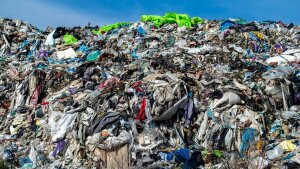
A young woman is doing research on a laptop. She is sitting on a park bench.
Image: Christoph Worsch (University of Jena)"I'm going to buy a top for tonight!", Henriette declares on the phone to her boyfriend Paul, with whom she wants to go to the F-Haus for the freshers' party. As soon as she enters the Swedish fashion store opposite the old town hall, she notices the unpleasant, chemical odour. When she looks at the blouses and shirts in the SALE, she compares the prices with those of tops she has found in shops that focus on fairly produced clothing. The shirts there cost more than five times as much. Because Henriette hasn't found anything, she goes to the second-hand shop on the market. A fellow student recommended that she should stop by here. The prices are completely different again. Henriette wonders how this comes about and how clothes are produced. So she starts to do some research...
Fast fashion
The textile industry is one of the largest industries dominating the global market. This is due to the enormous consumption, with German consumers buying an average of 60 items of clothing per year. At the same time, the textile industry also accounts for 10% of greenhouse emissions worldwide and is responsible for the growing mountains of waste in the Global South. This is mainly due to fast fashion and ultra-fast fashion, i.e. fashion trends that become outdated within a very short time. Instead, a lot of clothing is made from cheap materials at low cost and in poor conditions for society and the environment . The top fast fashion labels include Zara, H&M, Temu and, last but not least, Shein.
-
Consumption
A party top bought for a specific purpose is worn once on average. It then stays in the wardrobe for a long time and/or is thrown away. Consumers are guided by the fast fashion labels, which design and launch new collections within a week. The clothing consists of 70% synthetic fibres, which not only decompose very poorly and are difficult to recycle, but also release microplastics when washed. The production of cotton tops, although more recyclable, also performs poorly, as around 15,000 litres of water are needed to produce one kilogram of cotton.
-
Manufacture
Our clothes are often made in China, India and Turkey under poor working conditions. Working up to 75 hours a week, the workers earn very little money. In addition, there are health hazards, for example from dyeing, while many other labour rights are also completely disregarded.
-
Consumption
A large amount of rubbish stretches as far as the horizon. The rubbish consists exclusively of clothing.
Image: Adobe Stock; SashaDiscarded clothing, including in clothing containers, often ends up in countries of the global South, such as Kenya. There, our discarded clothing ends up in large markets, such as the Gikomba market in Nairobi, where it is sold in bundles and then returned to local retailers at a higher price. In most cases, our old clothes are burnt in landfills there, which emits a lot of CO2 and puts a heavy strain on the health of the people living and working there. All in all, this leads to a massive social and ecological crisis and to the fact that a domestic textile industry cannot even emerge.
Responsible consumption
Surprised, Henriette leans back on the park bench. She already knew that clothing consumption does not have a good offer of professorship, but she would never have thought that the impact on the environment, social systems and society in the countries where the clothes are produced and destroyed would be so comprehensively bad. Fortunately, she had decided against buying the top, she still has enough in her wardrobe. Should she never buy anything again? And what should parents do when their children outgrow their clothes so quickly? Henriette picks up her mobile phone again to find out how to consume responsibly.
Since the coronavirus pandemic, awareness of sustainable clothing consumption has increased. There are already fewer clothes hanging in German wardrobes, while more attention is being paid to sustainable and fair production. Platforms such as "Vinted" or "Sellpy" are very popular for giving discarded clothing a new lease of life. There are other options that significantly reduce the damage caused by clothing:
-
Second-hand, donations, swapping
Since 2025, old clothes can no longer be thrown in the bin but must be disposed of in used clothing containers . However, it makes more sense to swap clothes, sell them yourself via flea market platforms or donate them responsibly and directly. Clothes swap parties or swap racks are suitable for swapping. As an incentive, you can always remember that the CO2 emissions of swapped second-hand fashion that is not specially produced are 0.
Repurpose shopping: AsrkariExternal link is a Thuringian start-up that works in a similar way to Sellpy, with the difference that the profits go towards sustainable projects that sellers can decide|ruling|judgementExternal link for themselves.
-
Upcycling
Just because a shirt has a hole in it doesn't mean it has to be thrown away. The same applies to your favourite socks or a tear in your trouser leg. With the help of YouTube, other online tutorials, repair cafés or appropriate literature, you can learn simple techniques to extend the life of your clothes by repairing them . At the same time, pieces that you no longer like can be recoloured or upgraded using embroidery techniques. Upcycling is particularly fun in the context of joint meetings where you can support each other.
-
Awareness
Before buying a new item of clothing, you should consider whether you really need it. You should also pay attention to labels . The following questions can help: On what occasions can it be worn? What purpose does the purchase fulfil - is it just to satisfy your own hunger for something new? How often will the item of clothing be worn and will I still like it in three years' time?
-
Less is more
A maximum of three new items of clothing should be purchased per person per year. Children's clothes in particular, which are not worn for long, can be bought second-hand with a clear conscience. Perhaps there are children of a similar age in your circle of friends with whom you can swap clothes?
When buying new clothes, you should think about the material and consider it carefully: While synthetic fabrics are partly made from recycled plastic bottles but do not rot, natural fabrics such as cotton or linen consume a lot of water during production. However, the latter provide better heat regulation in winter and summer and are biodegradable.
-
Life extension
It is not uncommon for clothes to break because the care instructions are not followed. The washing instructions, which can be found on small labels on the clothing that are often cut off, should always be followed. This applies in particular to prints, which are otherwise quickly washed off.
-
Own use
There are various ways to campaign for sustainable consumption. This starts with consciously buying eco-labels and paying attention to fair production and does not end with the socio-political fight for a ban on fast fashion.
-
Helpful links
- Escape games on the topic of fashion: https://exit-fast-fashion.de/escape-game/External link
- Study on invisible sewing workers (Syrian refugees in Turkey): https://www.ci-romero.de/wp-content/uploads/2018/06/Invisible-workers_Turkey_Fair-Action_2017.pdfExternal link
- Criteria for green fashion: https://www.ci-romero.de/gruene-mode/#1636380259910-33b97bfe-ae4eExternal link
- Action manual for students with helpful ideas: https: //femnet.de/download/send/66-bildungsarbeit/293-aktiv-fuer-menschenrechte-in-der-mode-aktionshandbuch-fuer-studierende.htmlExternal link
- Why recycling is not the best solution: https://www.germanwatch.org/de/90129External link
- Seal check: https://siegelcheck.suedwind.at/External link
- Facts and materials on the topic of clean clothing: https://saubere-kleidung.de/materialien/External link
Nine dice form the word "Fastfashion". One hand turns the first two dice to the word "Slowfashion".
Image: Adobe Stock; DzmitryConclusion
Henriette puts her mobile phone away and is satisfied. She is bursting with ideas that she wants to tell Paul about tonight. She knows that she is not alone and wants to be more conscious about her clothing consumption. Even if she won't always be consistent, she's sure that she can change a lot about her behaviour - and she's not the only one to benefit. She believes it is important to set realistic goals and monitor her behaviour. Perhaps she should organise a clothes swap party with her friends? And what about all the tops she already has in her wardrobe - does she need a new one?
Much of the information and tips come from a workshop that was organised as part of the first Sustainability Week in cooperation with Greenpeace.


